Why eye care matters more than you think when studying for the Digital SAT
Studying for the Digital SAT is a sprint-and-marathon hybrid: short bursts of intense focus, long stretches of practice, and repeated sessions across weeks. Add hours in front of a screen, adaptive practice tests, and the occasional late-night cram session, and your eyes can begin to feel the strain. Eye strain isn’t just uncomfortable — it chips away at concentration, slows reading speed, and can make your practice sessions less efficient. Treating your eyes like a priority isn’t indulgent; it’s smart test preparation.
What is digital eye strain (and how it shows up)
Digital eye strain — sometimes called computer vision syndrome — covers a set of symptoms from prolonged screen use. For students prepping for the SAT, the most common signs are:
- Dry, gritty, or watery eyes
- Blurry or fluctuating vision during or after study sessions
- Headaches focused around the temples or behind the eyes
- Neck, shoulder, or upper-back discomfort from poor posture
- Difficulty concentrating after an hour or more of reading
These symptoms are rarely dangerous, but they do reduce study quality. The good news: many remedies are simple, inexpensive, and practical for busy students.
Start with the right environment
Before tweaking screen settings or scheduling breaks, get the basics right. A well-designed study environment reduces the load on your eyes and helps you sustain focus.
Lighting: avoid glare, aim for balanced light
Direct glare — from windows or overhead lights — forces your eyes to work harder. But low light is also a culprit: reading in dim rooms makes your pupils dilate and can increase strain. Aim for even, ambient lighting with a focused task light on your workspace.
- Position your desk perpendicular to windows so natural light falls across your work area instead of reflecting off the screen.
- Use a soft, adjustable desk lamp (warm-white LED around 2700–3000K) to illuminate books or notes without flooding the monitor.
- Avoid very bright overhead lights directly above the screen; indirect or diffused lighting is more comfortable.
Screen placement and posture: small changes, big payoff
Where your device sits and how you hold your posture influence how hard your eyes and neck must work. Follow these quick rules:
- Place the screen about an arm’s length away (roughly 20–30 inches) — farther if you find small text straining.
- Top of the screen should be at or slightly below eye level so your gaze drops gently downward about 10–20 degrees.
- Sit back in a chair with lumbar support. Keep shoulders relaxed and feet flat on the floor.
Optimize your device and display settings
Modern devices have settings designed to reduce strain — but they only help if you use them thoughtfully.
Brightness, contrast, and color temperature
Match your screen brightness to the room. If your screen looks like a light source in a dim room, turn it down. Conversely, a dim screen in bright rooms causes squinting. Color temperature matters too: warmer tones (more yellow) are easier on the eyes in the evening, while cooler tones (bluer light) can feel sharper during the day.
- Use automatic brightness when available, or manually adjust until text is comfortable to read without glare.
- Enable night mode or warm color temperature for evening study sessions to reduce blue-light exposure and help with sleep later.
Font size, contrast, and digital reading aids
If you’re using practice passages in Bluebook, online materials, or PDFs, increase font size and line spacing so you’re not forcing your eyes to hunt for words. High-contrast text (dark on light) usually reads best.
- Set default reading size so you can comfortably read without leaning forward.
- Use browser or PDF reader zoom to make passage text clean and easy to scan during timed practice.
- Consider reader modes that remove clutter (sidebars, ads) so your eyes track only the passage.
Smart studying rhythms: breaks, practice structure, and active rest
One of the most powerful ways to avoid eye strain is built into time itself: regular, intentional breaks. They restore vision, bolster attention, and improve retention.
The 20-20-20 rule and alternatives
The classic 20-20-20 rule says: every 20 minutes, look at something 20 feet away for 20 seconds. It’s simple, effective, and perfect for SAT sessions. If you prefer longer blocks, try:
- 50/10 rhythm: 50 minutes focused study, 10-minute break (good for deep practice like full-section timing).
- 25/5 Pomodoro: 25 minutes work, 5 minutes break — keeps momentum for shorter tasks like grammar drills.
During breaks, deliberately focus on distant objects, blink slowly, or step outside for a breath of fresh air. These micro-rests reduce eye surface dryness and reset attention.
Active rest: what to do during breaks
Not all breaks are equal. Active rest that moves your eyes, body, or both helps far more than scrolling social media on the same device.
- Eye rolls and focusing exercises: slowly shift focus from near (a book) to far (a tree or window), repeat 10 times.
- Neck and shoulder stretches: gentle rolls and stretches release tension that can contribute to headaches.
- Short walks or stair climbs: increase blood flow and reduce mental fatigue.
Practical routines to protect eyes across your SAT prep week
Integrate eye-friendly habits into your study calendar so they become automatic.
Sample weekly routine
Below is a simple schedule you can adapt to your life, homework, and test timeline.
| Day | Primary Focus | Study Blocks | Eye-care Actions |
|---|---|---|---|
| Monday | Reading practice (timed sections) | 2 × 50 mins | 50/10 rule; warm light evening |
| Tuesday | Math problem sets | 3 × 25 mins | 20-20-20 every 20 min; desktop at arm’s length |
| Wednesday | Grammar and writing drills | 4 × 25 mins | Use paper copies for one block; stretch breaks |
| Thursday | Full practice section | 1 full digital section | Bluebook practice; night-mode off for morning session |
| Friday | Review mistakes | 2 × 40 mins | Alternate screen and printed notes |
| Weekend | Full practice test or light review | Full test or light sessions | Schedule outdoor time and longer eye-rests |
Mix digital and paper
Wherever possible, print passages or math problems for at least one block a day. Your eyes get a break from backlit screens, and writing on paper engages memory differently — a double win for learning.
Quick eye exercises you can do anywhere
These exercises take minutes, need no equipment, and help maintain eye lubrication and flexibility.
Two-minute routine
- Close your eyes and take three slow, deep breaths.
- Blink normally for 10 seconds to rewet the eyes.
- Focus near (your thumb at 8–10 inches) for 10 seconds, then refocus on something far for 10 seconds. Repeat 6 times.
Neck and shoulder quick release
- Roll your shoulders gently forward and backward for 30 seconds.
- Slowly tilt your head left to right, holding each side for 8–10 seconds.
When to see an eye care professional
Most eye strain improves with the strategies above. But if you experience persistent blurred vision, double vision, severe headaches, or sudden loss of vision, see an eye doctor immediately. Also consider a professional eye exam if you haven’t had one in over a year — updated prescription lenses or advice on blue-light filters can make a big difference for heavy screen users.
Study smarter: combine eye care with test strategy
Reducing eye strain also improves the quality of your practice. Clearer vision helps you read passages faster, spot detail in graphs, and avoid careless mistakes. Here’s how to pair health habits with smart SAT prep.
Simulate test conditions, but protect your eyes
Practice in conditions that mirror test day (Bluebook, proper timing) for at least some full sessions. But don’t make every practice test a marathon of bad lighting and hanging shoulders. Alternate full test simulations with low-strain review days — the contrast helps sustain energy and learning.
Use targeted review to shorten screen time
Instead of redoing whole sections on-screen, try targeted review: print a subset of the most challenging problems and work through them on paper. This reduces screen hours while focusing practice where it matters.
Tech tools and habits that actually help
There’s no single gadget that eliminates eye strain, but some features and tools can help when used sensibly.
Bluebook practice and official tools
Familiarity with the testing platform reduces distractions and inefficient eye movements on test day. Use official Bluebook practice sessions to learn navigation, answer selection, and timing — then apply eye-care routines during those practice runs so good habits align with how you’ll actually test.
Screen filters, glasses, and apps
- Anti-glare screen protectors can cut reflections for laptop and tablet users.
- Blue-light glasses may help evening study comfort for some students, though evidence on long-term benefits varies. If you wear glasses, ask your optometrist about a prescription with an anti-reflective coating.
- Timing apps that enforce breaks (Pomodoro timers) are sensible tools — pick one that locks the screen or forces a break if you’re prone to skipping rests.
Nutrition, sleep, and the bigger picture
Eye health is part of whole-body health. Hydration, sleep, and good nutrition support clear thinking, fast reading, and stamina for long practice days.
Simple daily habits
- Stay hydrated: dry eyes are more likely when you’re dehydrated.
- Prioritize sleep: quality sleep repairs cognitive systems and reduces eye irritation.
- Eat foods rich in omega-3s, vitamin A, and antioxidants (fish, carrots, leafy greens) if you can — they support ocular health over time.
How personalized tutoring can protect your eyes and your score
Studying smarter, not harder, is the point — and tailored support can make that happen. Personalized tutoring, like the kind Sparkl offers, fits study schedules around your needs, reduces wasted screen time by focusing on high-impact content, and provides one-on-one guidance to build efficient, low-strain study habits. Working with a tutor means your practice sessions are targeted, your review is sharper, and your screen hours become purposeful rather than endless. Plus, tutors can recommend when to switch to paper, how to simulate Bluebook conditions without overdoing it, and which exercises to add to your routine.
Putting it all together: a day-of-study checklist
Here’s a practical checklist you can follow before and during your study blocks to keep eyes comfortable and focus high.
- Adjust screen brightness to match room lighting.
- Set up your screen at arm’s length and slightly below eye level.
- Begin with a printed warm-up passage for 25 minutes.
- Use the 20-20-20 rule during focused screen blocks.
- Take a 10-minute active break after longer blocks (walk, stretch, eyes-focus exercise).
- Finish with 10 minutes of review on paper to consolidate memory.
Small changes, big results: student stories
Students often report surprising gains from tiny shifts. One test-taker I coached swapped one nightly two-hour screen cram for a structured 50/10 schedule with printed notes and saw fewer headaches and better reading speed. Another used warm color temperature in the evenings and moved one hour of late-night study to the morning; not only did eye discomfort drop, but sleep quality improved, and test-day focus felt stronger.
Practical product suggestions (non-brand specific)
There’s a wide range of accessories that support eye comfort. Consider:
- A soft, adjustable desk lamp with dimming and warm color settings.
- An anti-glare screen protector for tablets or laptops.
- A comfortable chair with lumbar support to prevent neck strain that can lead to eye discomfort.
- A simple timer app to enforce breaks (Pomodoro or 50/10 mode).
Final thoughts: care for your eyes, sharpen your score
Preparing for the Digital SAT is a test of knowledge, strategy, and stamina. Eye strain steals all three. By optimizing lighting, ergonomics, device settings, and your study rhythm — and mixing in paper-based practice and active breaks — you preserve focus and make every hour of prep more valuable. If you ever feel stuck designing the right plan, personalized tutoring (like Sparkl’s one-on-one guidance and tailored study plans) can help you build efficient routines that protect your eyes and elevate your score. When your eyes are rested, your mind is clearer — and that’s the competitive edge you want on test day.
Quick reference: top 10 eye-care tips for SAT study
- Use the 20-20-20 rule or a 50/10 rhythm for longer sessions.
- Match screen brightness to ambient light; avoid glare.
- Place your screen an arm’s length away and slightly below eye level.
- Alternate digital practice with printed materials daily.
- Blink frequently and use short focusing exercises during breaks.
- Use warm color temperature for evening study to reduce blue light.
- Tune font size and contrast so text is easy to scan without leaning forward.
- Stay hydrated and prioritize sleep to reduce dryness and fatigue.
- Schedule outdoor time to let your eyes rest and reset naturally.
- See an eye doctor for persistent symptoms or if you haven’t had an exam in a year.
Ready to study with clarity?
Protecting your eyes is one of the most practical, high-return habits you can build during SAT prep. Small adjustments to lighting, posture, and study rhythms yield immediate comfort and long-term gains in concentration and performance. If you’d like help building a study plan that reduces screen time while maximizing score improvements, consider working with a personalized tutor who can tailor sessions to your goals and recommend specific practices and breaks — a strategy that preserves both your vision and your momentum.
Remember
Study well, rest often, and treat your eyes like the essential instruments they are — because on test day, bright eyes and a sharp mind are the best combo.
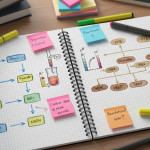
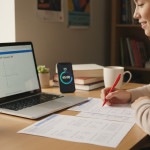
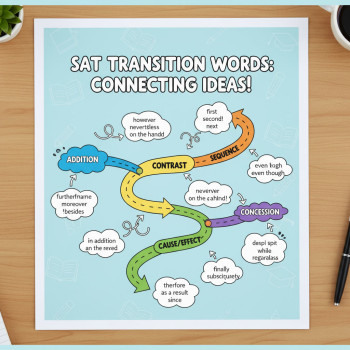


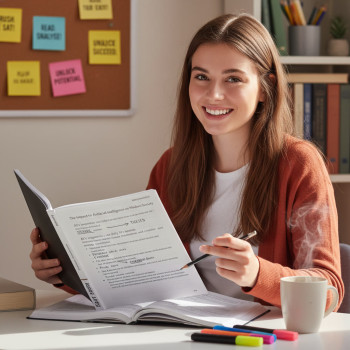
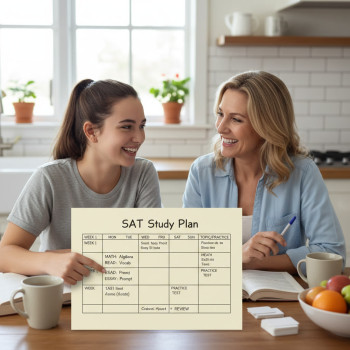

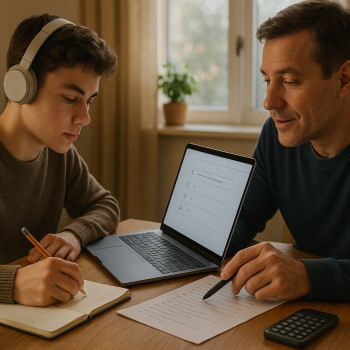









No Comments
Leave a comment Cancel